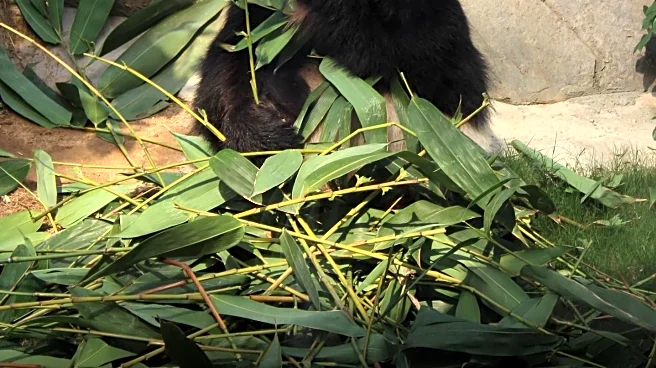What's Happening?
The Smithsonian National Zoo in Washington, D.C. hosted a birthday celebration for Qing Bao, a giant panda, marking her fourth birthday. The event attracted a crowd of 200 people, including families and panda enthusiasts from various locations such as Massachusetts, Texas, and Japan. Qing Bao, who arrived at the zoo last October, was treated to a special fruitsicle cake made from diluted beet, apple, and pineapple juices, adorned with her favorite fruits. The celebration included themed decorations and panda-themed attire worn by attendees. Qing Bao's birthday marks her first at the zoo since her arrival from the China Conservation and Research Center for the Giant Panda in Sichuan.
Why It's Important?
The celebration of Qing Bao's birthday highlights the cultural and educational significance of giant pandas in the United States. As a symbol of international cooperation in wildlife conservation, the presence of pandas at the Smithsonian National Zoo fosters public interest in conservation efforts and biodiversity. The event also serves as an opportunity for the zoo to engage with the community, promoting awareness about the challenges faced by endangered species. The excitement surrounding Qing Bao's birthday underscores the role of zoos in providing educational experiences and fostering a connection between the public and wildlife.
What's Next?
Looking ahead, the zoo plans to collaborate with partners in China to determine the appropriate time for breeding Qing Bao and Bao Li, another giant panda at the zoo. As both pandas are still young, the zoo will monitor their development and readiness for breeding, which typically occurs between the ages of 5 and 7. The zoo will continue to host public events to celebrate milestones in the pandas' lives, further engaging the community in conservation efforts.
Beyond the Headlines
The phenomenon of pseudopregnancy observed in Qing Bao offers insights into the reproductive behaviors of giant pandas. This condition, where a female panda exhibits pregnancy-like symptoms without being pregnant, provides valuable information for researchers studying panda biology and reproduction. Understanding such behaviors can aid in improving breeding programs and ensuring the health and well-being of pandas in captivity.












